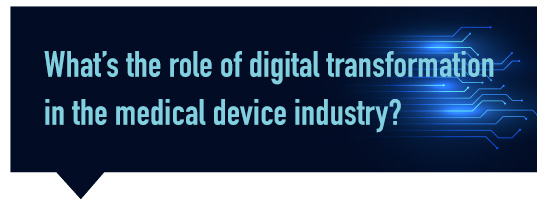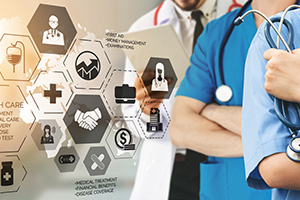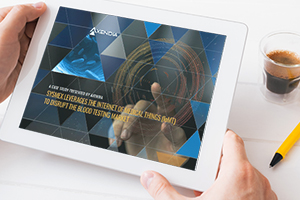Thoughts on the Digital Transformation of the Remote Monitoring Medical Device Industry
Today, many medical devices can be remotely
monitored, thanks to embedded technologies like
the Internet of Things (IoT). Some medical device
manufacturers are leveraging such capabilities to
enhance the efficiency of service operations. But
truly forward-thinking companies are using the
technology to digitally transform their entire
business operations. They use the data to provide
new services, incorporate information gained into
the product lifecycle, and more.
To get a better understanding of digital transformation in the medical device industry, common challenges and obstacles to transforming, and potential benefits, we recently sat down with Anthony Moffa, Sr. Director, ThingWorx IIoT Platform at PTC. Here is a summary of our conversation.

RTInsights: We've seen how digital transformation is key to many industries. What role can it play in the medical device industry?
Moffa: It's a continuation of something that was started about 20 years ago. The medical device industry was one of the first industries to really start embracing connected services. It started out as machine-to-machine or remote device management and eventually evolved into the Internet of Things. And the beauty of all that was, the industry had the opportunity to do the diagnostics of the equipment from a centralized location, and that obviously helps improve your service experience, customer satisfaction, all of those things. Even with all that, there's still pressure. When I was in service,
To get a better understanding of digital transformation in the medical device industry, common challenges and obstacles to transforming, and potential benefits, we recently sat down with Anthony Moffa, Sr. Director, ThingWorx IIoT Platform at PTC. Here is a summary of our conversation.

RTInsights: We've seen how digital transformation is key to many industries. What role can it play in the medical device industry?
Moffa: It's a continuation of something that was started about 20 years ago. The medical device industry was one of the first industries to really start embracing connected services. It started out as machine-to-machine or remote device management and eventually evolved into the Internet of Things. And the beauty of all that was, the industry had the opportunity to do the diagnostics of the equipment from a centralized location, and that obviously helps improve your service experience, customer satisfaction, all of those things. Even with all that, there's still pressure. When I was in service,
we were always asked to do more with less, for
less. So, if you think about servicing organizations,
they’d release a new product and sell the product.
If successful, the installed base gradually grows,
and grows, and grows. Yet, you don't want to grow
your service organization at the same rate, right?
And that's one of the reasons why so many people are adopting digital. Because if you do the math, if you double your installed base, you will have to double the number of people to service that base. If your service organization says, “We want to double our service income,“ you have to double the number of people because there is a direct relationship: I need so many technicians to create so much revenue. But as you become capable of integrating a digital format into your workflow, you can really start to streamline operations. Certainly, remote service helped. It made it easy to diagnose device problems. But you still had to dispatch somebody to fix things, on occasion. So now device manufacturers are starting to look at things like self-service—asking, “Could my customer fix certain things?”
That thinking spawned the role of a medical device technician, so-called med techs. And a lot of the hospitals started looking at that because they could speed up the process of medical device maintenance, and maybe do preventive maintenance and all that sort of thing. But the problem with that is, you have to train everybody on every piece of equipment. That is challenging enough, but there is also liability associated with this approach. So, this self-service model where hospital med techs do the work really hasn't taken off as quickly as everybody would think. One thing that could help is to start doing things like augmented reality or assisted support. For example, PTC’s Vuforia Chalk enables you to do telestration— drawing a freehand sketch over a moving or still video image—with customers on-site. It is a nice addition to the digitization of service because if I'm
And that's one of the reasons why so many people are adopting digital. Because if you do the math, if you double your installed base, you will have to double the number of people to service that base. If your service organization says, “We want to double our service income,“ you have to double the number of people because there is a direct relationship: I need so many technicians to create so much revenue. But as you become capable of integrating a digital format into your workflow, you can really start to streamline operations. Certainly, remote service helped. It made it easy to diagnose device problems. But you still had to dispatch somebody to fix things, on occasion. So now device manufacturers are starting to look at things like self-service—asking, “Could my customer fix certain things?”
That thinking spawned the role of a medical device technician, so-called med techs. And a lot of the hospitals started looking at that because they could speed up the process of medical device maintenance, and maybe do preventive maintenance and all that sort of thing. But the problem with that is, you have to train everybody on every piece of equipment. That is challenging enough, but there is also liability associated with this approach. So, this self-service model where hospital med techs do the work really hasn't taken off as quickly as everybody would think. One thing that could help is to start doing things like augmented reality or assisted support. For example, PTC’s Vuforia Chalk enables you to do telestration— drawing a freehand sketch over a moving or still video image—with customers on-site. It is a nice addition to the digitization of service because if I'm



